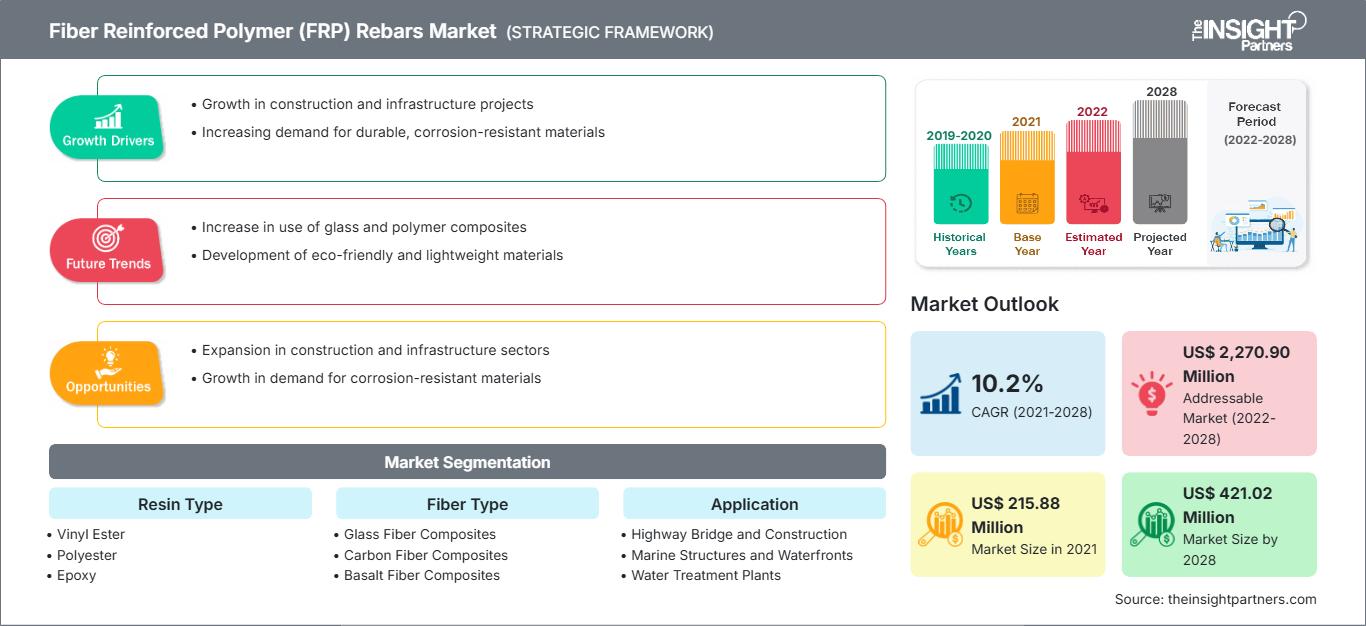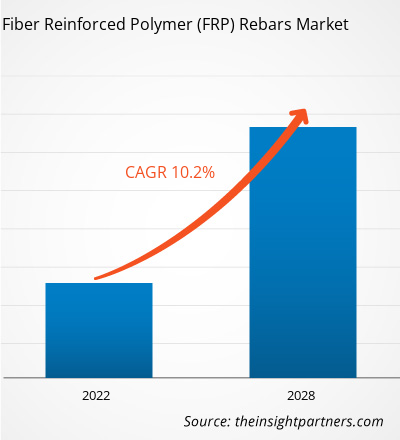섬유 강화 폴리머(FRP) 철근 시장은 2021년 2억 1,588만 달러에서 2028년 4억 2,102만 달러로 성장할 것으로 예상되며, 2022년부터 2028년까지 연평균 성장률 10.2%로 성장할 것으로 예상됩니다.
콘크리트는 압축에는 강하고 인장에는 약하기 때문에 일반적으로 인장 및 압축에 강한 건축 자재를 만들기 위해 보강됩니다. 이러한 보강재는 일반적으로 저렴한 가격, 높은 강도, 높은 탄성을 가진 강철로 구성됩니다. 그러나 강철 부식은 정부와 자산 소유주에게 노후화된 인프라를 교체하거나 수리하는 데 수십억 달러의 유지 보수 비용을 초래할 수 있습니다. 부식을 방지하는 데 사용할 수 있는 콘크리트 보강재의 대안은 거의 없습니다. 예를 들어, 일부 제조업체는 스테인리스강 철근을 제공하지만, 섬유 강화 폴리머 철근은 콘크리트 보강용 기존 강철 철근에 대한 부식 방지 대안으로 사용할 수 있습니다. 이 FRP 철근은 폴리머 매트릭스와 유리, 탄소 또는 현무암 섬유의 조합으로 제작됩니다. 이 소재는 녹슬지 않고 강철보다 훨씬 가벼우며 열을 전달하지 않고 인장 강도가 거의 4배에 달합니다. 이러한 내부식성 덕분에 섬유 강화 폴리머는 옹벽, 교각, 방파제, 안벽, 케이슨, 데크, 방파제, 파일, 운하, 해양 플랫폼, 수영장, 수족관 등 다양한 건설 분야에 최적의 대안입니다. 또한, 전자기적으로 민감한 분야에서도 FRP 철근의 유리 및 폴리머 비전도성 특성은 전류를 전달하거나 낙뢰를 유인하거나 주변 전기 장치의 작동을 방해하지 않습니다. 따라서 섬유 강화 폴리머는 알루미늄 및 구리 제련 공장, 공항 타워, 원자력 발전소, 특수 군사 구조물, 전기 및 전화 송전탑, 전기 또는 전화 장비가 들어 있는 맨홀, 자기공명영상(MRI) 장비가 있는 병원에서 강철보다 더 안전한 대안이 됩니다.
이 보고서의 일부, 국가 수준 분석, Excel 데이터 팩을 포함하여 모든 보고서에 대한 사용자 정의를 무료로 받을 수 있을 뿐만 아니라 스타트업 및 대학을 위한 훌륭한 제안 및 할인을 이용할 수 있습니다
섬유 강화 폴리머(FRP) 철근 시장: 전략적 통찰력

-
이 보고서의 주요 주요 시장 동향을 확인하세요.이 무료 샘플에는 시장 동향부터 추정 및 예측에 이르기까지 데이터 분석이 포함됩니다.
시장 분석
건설 활동 증가로 섬유 강화 폴리머(FRP) 철근 시장 성장 촉진
건설 산업은 전 세계 경제 발전에 크게 기여하는 산업 중 하나입니다. 전 세계적으로 인프라 개발에 대한 정부 지원이 확대됨에 따라 건설 산업은 빠르게 성장하고 있습니다. 예를 들어, 인도는 2019년부터 2023년까지 국가 인프라 파이프라인을 통해 인프라에 1조 4천억 달러를 투자할 계획입니다. 정부는 이 파이프라인에 전력, 교량, 댐, 도로, 도시 인프라 개발 등의 인프라를 포함시켰습니다. 고강도, 내동결성 및 제빙염 내성, 교통 방해를 최소화하면서 설치 시간이 짧은 등 유리한 물성 덕분에 섬유 강화 폴리머는 교량 구조물의 귀중한 대체 건축 자재로 자리 잡았습니다. 각국 정부의 이러한 정책은 섬유 강화 폴리머(FRP) 철근 시장의 성장을 촉진할 것으로 예상됩니다.
수지 종류별 분석
전 세계 섬유 강화 폴리머(FRP) 철근 시장은 수지 종류에 따라 비닐 에스테르, 폴리에스터, 에폭시 등으로 구분됩니다. 2021년에는 비닐 에스테르 부문이 시장 점유율 1위를 차지했습니다. 비닐 에스테르 수지는 강도가 높고, 부식, 연료, 화학 물질 또는 증기에 대한 내성이 우수하며, 기계적 인성을 제공합니다. 또한 내구성, 내열성, 인장 신율도 우수합니다. 이 수지는 단섬유 또는 탄소 섬유에 함침시켜 FRP 철근을 생산할 수 있습니다. 대부분의 섬유 강화 폴리머 철근 제조업체는 비닐 에스테르 수지를 사용합니다. 비닐 에스테르의 비용 효율성은 이 부문의 성장을 촉진했습니다.
Owens Corning; KODIAC Fiberglass Rebar; MARSHALL COMPOSITE TECHNOLOGIES, LLC; TUF-BAR; Armastek USA; Pultron Composites; FiRep Inc.;
PULTRALL, Inc.; Schock Bauteile GmbH; 그리고 Dextra Group은 세계섬유 강화 폴리머
(FRP) 철근 시장의 주요 기업입니다. 주요 기업들은 인수합병 및 제품 출시와 같은 전략을 통해 지역적 입지와 고객층을 확대하고 있습니다. 예를 들어, Pultron Composites는 사우디아라비아 최대 석유 회사인 사우디 아람코와 파트너십을 맺고 사우디아라비아 내 유리 섬유 강화 폴리머(GFRP) 철근 생산 시설을 확대했습니다.
섬유 강화 폴리머(FRP) 철근 시장 지역별 통찰력
The Insight Partners의 분석가들은 예측 기간 동안 섬유 강화 폴리머(FRP) 철근 시장에 영향을 미치는 지역별 동향과 요인을 면밀히 분석했습니다. 이 섹션에서는 북미, 유럽, 아시아 태평양, 중동 및 아프리카, 그리고 중남미 지역의 섬유 강화 폴리머(FRP) 철근 시장 부문 및 지역별 분포도 살펴봅니다.
섬유 강화 폴리머(FRP) 철근 시장 보고서 범위
| 보고서 속성 | 세부 |
|---|---|
| 시장 규모 2021 | US$ 215.88 Million |
| 시장규모별 2028 | US$ 421.02 Million |
| 글로벌 CAGR (2021 - 2028) | 10.2% |
| 이전 데이터 | 2019-2020 |
| 예측 기간 | 2022-2028 |
| 다루는 세그먼트 |
By 수지 종류
|
| 포함된 지역 및 국가 |
북미
|
| 시장 선도 기업 및 주요 회사 프로필 |
|
섬유 강화 폴리머(FRP) 철근 시장 참여자 밀도: 비즈니스 역학에 미치는 영향 이해
섬유 강화 폴리머(FRP) 철근 시장은 소비자 선호도 변화, 기술 발전, 그리고 제품의 이점에 대한 인식 제고 등의 요인으로 인한 최종 사용자 수요 증가에 힘입어 빠르게 성장하고 있습니다. 수요가 증가함에 따라 기업들은 제품 라인업을 확장하고, 소비자 니즈를 충족하기 위한 혁신을 추진하며, 새로운 트렌드를 적극 활용하고 있으며, 이는 시장 성장을 더욱 가속화하고 있습니다.

- 을 얻으세요 섬유 강화 폴리머(FRP) 철근 시장 주요 주요 플레이어 개요
보고서 스포트라이트
- 섬유 강화 폴리머(FRP) 철근 산업의 진보적 추세는 플레이어가 효과적인 장기 전략을 개발하는 데 도움이 됩니다.
- 선진 및 개발도상 시장에서 성장을 확보하기 위해 회사가 채택한 사업 성장 전략
- 2022년부터 2028년까지 글로벌 섬유 강화 폴리머(FRP) 철근 시장에 대한 정량적 분석
- 섬유 강화 폴리머(FRP) 철근 수요 추정
- 시장 성장을 예측하기 위해 업계에서 운영되는 구매자와 공급업체의 효율성을 보여주는 포터 분석
- 경쟁 시장 시나리오와 섬유 강화 폴리머(FRP) 철근 수요를 이해하기 위한 최근 개발
- 시장 추세 및 전망, 그리고 글로벌 섬유 강화 폴리머(FRP) 철근 시장 성장을 주도하고 제한하는 요인
- 상업적 관심을 뒷받침하는 전략 이해 글로벌 섬유 강화 폴리머(FRP) 철근 시장 성장과 관련하여 의사 결정 과정에 도움이 되는 정보를 제공합니다.
- 다양한 시장 노드별 글로벌 섬유 강화 폴리머(FRP) 철근 시장 규모
- 글로벌 섬유 강화 폴리머(FRP) 철근 시장에 대한 자세한 개요 및 세분화, 그리고 산업 역학
- 성장 가능성이 유망한 다양한 지역의 글로벌 섬유 강화 폴리머(FRP) 철근 시장 규모
"2028년까지의 섬유 강화 폴리머(FRP) 철근 시장 분석"은 섬유 강화 폴리머(FRP) 철근 시장 동향 분석에 중점을 둔 화학 및 재료 산업에 대한 전문적이고 심층적인 연구입니다. 본 보고서는 상세한 세분화를 통해 시장 개요를 제공하는 것을 목표로 합니다. 섬유 강화 폴리머(FRP) 철근 시장은 수지 유형, 섬유 유형, 용도 및 지역별로 세분화됩니다. 수지 유형을 기준으로 시장은 비닐 에스테르, 폴리에스터, 에폭시 등으로 세분화됩니다. 섬유 종류에 따라 시장은 유리 섬유 복합재, 탄소 섬유 복합재, 현무암 섬유 복합재로 구분됩니다. 용도에 따라 시장은 고속도로 교량 및 건설, 해양 구조물 및 해안가, 수처리 시설 등으로 구분됩니다. 지리적 위치에 따라 시장은 북미, 유럽, 아시아 태평양, 중동 및 아프리카, 중남미의 5개 주요 지역으로 구분됩니다. 2021년에는 북미 지역이 섬유 강화 폴리머(FRP) 철근 시장을 주도했습니다. 그러나 예측 기간 동안 아시아 태평양 지역이 가장 높은 연평균 성장률을 기록할 것으로 예상됩니다.
- 과거 분석(2년), 기준 연도, CAGR을 포함한 예측(7년)
- PEST 및 SWOT 분석
- 시장 규모 가치/거래량 - 글로벌, 지역, 국가
- 산업 및 경쟁 환경
- Excel 데이터세트
최근 보고서
사용 후기
구매 이유
- 정보에 기반한 의사 결정
- 시장 역학 이해
- 경쟁 분석
- 고객 인사이트
- 시장 예측
- 위험 완화
- 전략 기획
- 투자 타당성 분석
- 신흥 시장 파악
- 마케팅 전략 강화
- 운영 효율성 향상
- 규제 동향에 발맞춰 대응






















 무료 샘플 받기 - 섬유 강화 폴리머(FRP) 철근 시장
무료 샘플 받기 - 섬유 강화 폴리머(FRP) 철근 시장